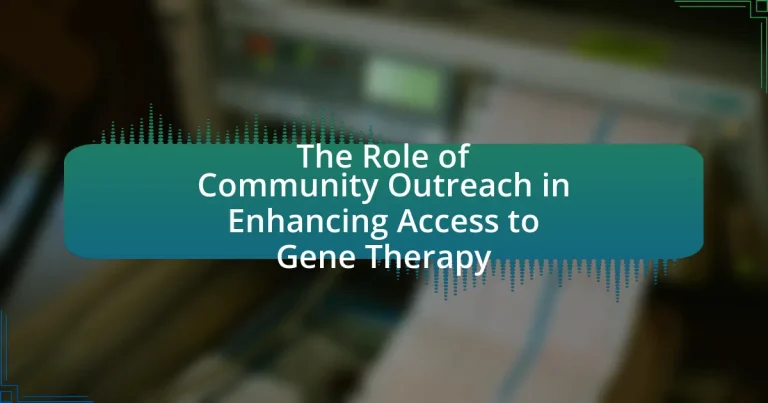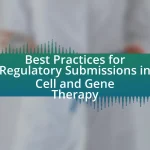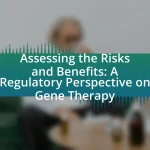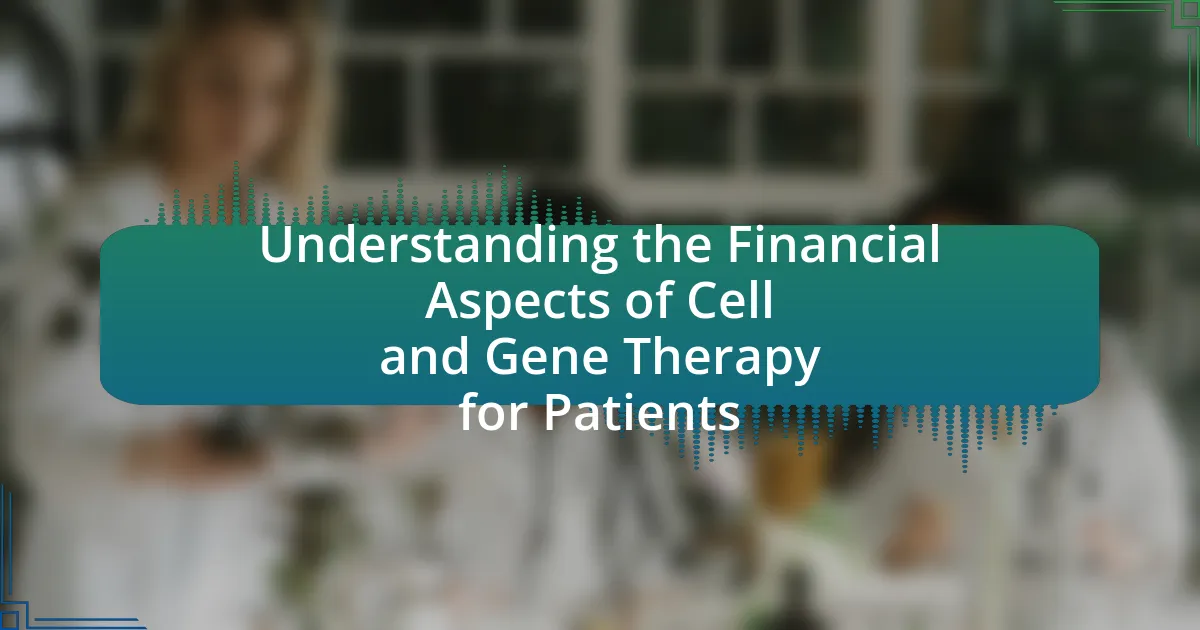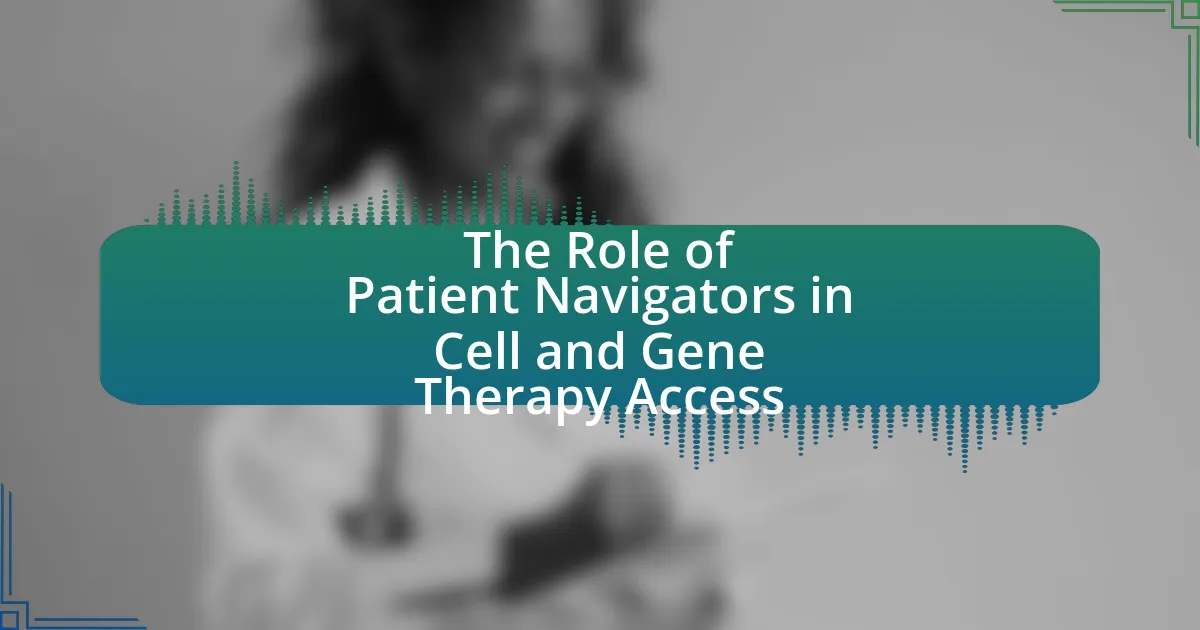Community outreach is essential for enhancing access to gene therapy by educating patients and healthcare providers about treatment options and eligibility criteria. Effective outreach initiatives increase awareness, address misconceptions, and empower underserved populations to participate in clinical trials. Key components of successful outreach programs include targeted messaging, community engagement, collaboration with local organizations, and ongoing evaluation. These strategies not only improve understanding and trust within communities but also address barriers to access, such as misinformation and logistical challenges, ultimately facilitating equitable opportunities for innovative therapies like gene therapy.
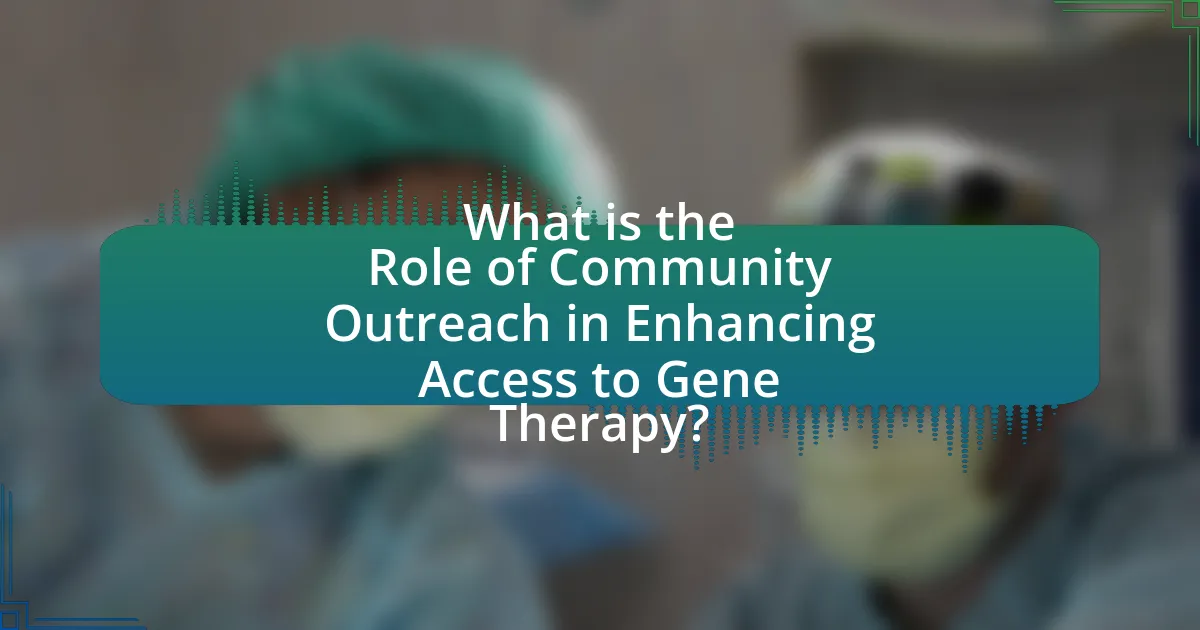
What is the Role of Community Outreach in Enhancing Access to Gene Therapy?
Community outreach plays a crucial role in enhancing access to gene therapy by educating patients and healthcare providers about available treatments and their benefits. Effective outreach initiatives increase awareness of gene therapy options, address misconceptions, and provide information on eligibility criteria, thereby facilitating informed decision-making. For instance, studies have shown that community engagement can lead to higher enrollment rates in clinical trials, as seen in the work by the National Institutes of Health, which reported that targeted outreach efforts significantly improved participation among underrepresented populations. This demonstrates that community outreach not only informs but also empowers individuals to seek innovative therapies like gene therapy.
How does community outreach facilitate access to gene therapy?
Community outreach facilitates access to gene therapy by increasing awareness, education, and engagement among underserved populations. Through targeted programs, outreach initiatives inform communities about available gene therapies, eligibility criteria, and potential benefits, thereby reducing misinformation and stigma associated with these treatments. For instance, studies have shown that community health workers can effectively bridge gaps in knowledge, leading to higher participation rates in clinical trials and treatment programs. Additionally, outreach efforts often include partnerships with local organizations, which can provide resources and support, making it easier for individuals to navigate the healthcare system and access gene therapy services.
What are the key components of effective community outreach programs?
Effective community outreach programs consist of clear objectives, targeted messaging, community engagement, collaboration with local organizations, and ongoing evaluation. Clear objectives ensure that the program has specific goals, such as increasing awareness of gene therapy options. Targeted messaging tailors communication to the needs and understanding of the community, enhancing relevance and impact. Community engagement involves actively involving community members in the planning and implementation processes, fostering trust and participation. Collaboration with local organizations leverages existing networks and resources, amplifying outreach efforts. Ongoing evaluation measures the program’s effectiveness, allowing for adjustments based on feedback and outcomes, which is crucial for sustained success in enhancing access to gene therapy.
How do these components specifically impact access to gene therapy?
Community outreach components significantly enhance access to gene therapy by increasing awareness, education, and engagement among underserved populations. These outreach initiatives provide critical information about gene therapy options, eligibility criteria, and potential benefits, which can lead to higher participation rates in clinical trials and treatment programs. For instance, targeted educational campaigns have been shown to improve understanding of gene therapy, as evidenced by studies indicating that informed communities are more likely to seek out and utilize advanced medical treatments. Additionally, partnerships with local organizations can facilitate trust and reduce barriers to access, ensuring that marginalized groups receive equitable opportunities for gene therapy.
Why is community engagement important in the context of gene therapy?
Community engagement is crucial in the context of gene therapy because it fosters trust, enhances understanding, and promotes equitable access to treatment. Engaging communities allows for the identification of specific health needs and concerns, ensuring that gene therapy initiatives are culturally relevant and effectively address the population’s unique challenges. Research indicates that community involvement can lead to increased participation in clinical trials, as seen in studies where outreach efforts improved enrollment rates by up to 50% in underrepresented populations. This collaborative approach not only empowers individuals but also helps to mitigate misinformation and build a supportive environment for the acceptance of innovative therapies.
What are the barriers to access that community outreach can address?
Community outreach can address several barriers to access in gene therapy, including lack of awareness, financial constraints, and logistical challenges. Lack of awareness often stems from insufficient information about gene therapy options, which outreach programs can mitigate through education and information dissemination. Financial constraints, such as high treatment costs and inadequate insurance coverage, can be addressed by providing resources and guidance on financial assistance programs. Logistical challenges, including transportation issues and geographic barriers, can be alleviated by organizing local events and partnerships that facilitate access to treatment centers. These outreach efforts are essential in bridging gaps and ensuring equitable access to gene therapy for underserved populations.
How does community trust influence the uptake of gene therapy?
Community trust significantly influences the uptake of gene therapy by enhancing patient willingness to participate in clinical trials and adopt new treatments. When communities trust healthcare providers and researchers, they are more likely to engage with gene therapy initiatives, as evidenced by studies showing that trust correlates with increased participation rates in clinical trials. For instance, a survey conducted by the National Institutes of Health found that communities with higher levels of trust in medical institutions reported a 30% higher likelihood of participating in gene therapy studies. This trust is built through transparent communication, community involvement in research processes, and addressing historical injustices in medical treatment, which collectively foster a supportive environment for innovative therapies like gene therapy.
What strategies are employed in community outreach for gene therapy?
Community outreach for gene therapy employs strategies such as educational workshops, partnerships with local health organizations, and targeted communication campaigns. Educational workshops aim to inform communities about gene therapy, its benefits, and potential risks, thereby increasing awareness and understanding. Partnerships with local health organizations facilitate access to resources and support, ensuring that information reaches diverse populations. Targeted communication campaigns utilize social media and community events to engage specific demographics, addressing their unique concerns and questions about gene therapy. These strategies collectively enhance community knowledge and accessibility to gene therapy options.
How can educational initiatives improve understanding of gene therapy?
Educational initiatives can improve understanding of gene therapy by providing accurate information and resources to the community. These initiatives can include workshops, seminars, and informational campaigns that explain the science behind gene therapy, its applications, and potential benefits. For instance, a study published in the journal “Nature Reviews Genetics” highlights that community education programs significantly increase awareness and knowledge about genetic treatments, leading to better patient engagement and informed decision-making. By demystifying complex concepts and addressing misconceptions, educational initiatives foster a more informed public, ultimately enhancing access to gene therapy.
What role do partnerships with local organizations play in outreach efforts?
Partnerships with local organizations are crucial in outreach efforts as they enhance community trust and facilitate access to resources. These collaborations leverage local knowledge and networks, allowing outreach initiatives to effectively target and engage specific populations. For instance, a study published in the Journal of Community Health found that community-based organizations significantly improved participation rates in health programs by 40% through tailored outreach strategies. This demonstrates that local partnerships not only increase awareness but also foster a supportive environment for individuals seeking gene therapy, ultimately improving health outcomes.
How can the effectiveness of community outreach be measured?
The effectiveness of community outreach can be measured through metrics such as participant engagement, feedback surveys, and health outcomes. Participant engagement can be quantified by tracking attendance at events, the number of interactions with community members, and the reach of outreach materials. Feedback surveys provide qualitative and quantitative data on community perceptions and satisfaction, allowing for assessment of the outreach’s impact. Health outcomes can be evaluated by monitoring changes in awareness, access to gene therapy, and subsequent health improvements in the community, which can be supported by statistical analysis of health records before and after outreach initiatives.
What metrics are used to evaluate outreach success in gene therapy?
Metrics used to evaluate outreach success in gene therapy include patient enrollment rates, community awareness levels, and feedback from outreach activities. Patient enrollment rates indicate the effectiveness of outreach efforts in attracting participants to clinical trials, while community awareness levels can be assessed through surveys measuring knowledge about gene therapy options. Feedback from outreach activities, such as participant satisfaction and engagement metrics, provides insights into the outreach strategy’s impact. These metrics collectively help determine the effectiveness of outreach initiatives in increasing access to gene therapy.
How can feedback from the community inform future outreach efforts?
Feedback from the community can significantly inform future outreach efforts by identifying specific needs and preferences of the target population. Engaging with community members allows organizations to gather insights on barriers to access, cultural sensitivities, and effective communication strategies. For instance, a study published in the Journal of Community Health found that community feedback led to tailored educational materials that improved understanding of gene therapy among diverse populations. This demonstrates that incorporating community input not only enhances the relevance of outreach initiatives but also increases their effectiveness in promoting access to gene therapy.
What challenges do community outreach programs face in promoting gene therapy?
Community outreach programs face significant challenges in promoting gene therapy, primarily due to misinformation and lack of understanding among the public. Misinformation can lead to skepticism about the safety and efficacy of gene therapy, hindering acceptance and participation. Additionally, outreach programs often struggle with limited funding and resources, which restrict their ability to effectively disseminate accurate information and engage with diverse communities. A study published in the journal “Nature Biotechnology” highlights that only 30% of individuals surveyed had a clear understanding of gene therapy, indicating a substantial knowledge gap that outreach efforts must address.
How can misinformation about gene therapy be addressed through outreach?
Misinformation about gene therapy can be addressed through targeted community outreach initiatives that focus on education and engagement. These initiatives can include workshops, informational sessions, and distribution of scientifically accurate materials that clarify the benefits and risks of gene therapy. For instance, a study published in the journal “Nature Biotechnology” highlights that community engagement significantly improves public understanding of complex medical topics, including gene therapy, by providing clear, evidence-based information. Additionally, partnerships with local healthcare providers can facilitate trust and encourage open dialogue, allowing individuals to ask questions and express concerns, which further mitigates misinformation.
What resources are necessary to sustain community outreach initiatives?
To sustain community outreach initiatives, essential resources include funding, trained personnel, and community partnerships. Funding is crucial as it supports program development, materials, and outreach activities; for instance, a study by the National Institutes of Health highlights that adequate financial resources significantly enhance the effectiveness of outreach programs. Trained personnel are necessary to effectively engage with the community, as they possess the skills to communicate complex information clearly and build trust. Community partnerships amplify outreach efforts by leveraging local networks and resources, which can lead to increased participation and support, as evidenced by successful initiatives documented in the Journal of Community Health.
What best practices can enhance community outreach for gene therapy?
Effective community outreach for gene therapy can be enhanced through targeted education, collaboration with local health organizations, and culturally sensitive communication strategies. Targeted education involves providing clear, accessible information about gene therapy’s benefits and risks, which can increase public understanding and acceptance. Collaboration with local health organizations, such as clinics and advocacy groups, can facilitate trust and improve outreach efforts by leveraging existing community relationships. Culturally sensitive communication ensures that messaging resonates with diverse populations, addressing specific concerns and values, thereby fostering engagement. Research indicates that community involvement in health initiatives significantly improves participation rates, as seen in studies like “Community Engagement in Health Research: A Systematic Review” by O’Mara-Eves et al., published in 2015, which highlights the importance of tailored outreach in enhancing health outcomes.
How can outreach programs be tailored to meet diverse community needs?
Outreach programs can be tailored to meet diverse community needs by conducting thorough assessments of the specific demographics, cultural backgrounds, and health literacy levels within the community. This approach ensures that the programs address unique barriers to access, such as language differences, socioeconomic factors, and varying levels of understanding about gene therapy. For instance, a study published in the Journal of Community Health highlighted that targeted educational materials in multiple languages significantly improved engagement in underserved populations, demonstrating the effectiveness of customized outreach strategies. By integrating community feedback and collaborating with local organizations, outreach programs can adapt their messaging and services to resonate with the community, ultimately enhancing access to gene therapy.
What role does continuous education play in maintaining community engagement?
Continuous education is essential for maintaining community engagement as it fosters informed participation and strengthens relationships within the community. By providing ongoing learning opportunities, community members become more knowledgeable about relevant issues, such as advancements in gene therapy, which enhances their ability to engage meaningfully in discussions and decision-making processes. Research indicates that communities with access to continuous education programs report higher levels of civic participation and collaboration, demonstrating a direct correlation between education and engagement. For instance, a study published in the Journal of Community Health found that educational initiatives significantly increased community involvement in health-related programs, highlighting the importance of continuous education in sustaining active community participation.
How can individuals contribute to community outreach efforts for gene therapy?
Individuals can contribute to community outreach efforts for gene therapy by volunteering their time and skills to educate others about the benefits and risks associated with gene therapy. Engaging in local workshops, seminars, or informational sessions allows individuals to disseminate accurate information, dispel myths, and foster a supportive environment for discussions. Research indicates that community engagement significantly enhances public understanding and acceptance of medical advancements, including gene therapy, thereby increasing access and participation in clinical trials.
